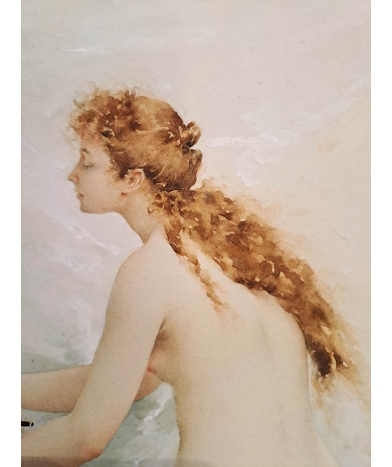Guillaume Dubufe (1853–1909) - Young woman playing the violin
Gouache watercolor on black pencil lines
Dimensions : H. 39 x L. 19 cm (with frame: H. 58 x L.40 cm )
Guillaume Dubufe, born in 1853, is an official French painter who is part of the great academic tradition of the 19th century. A remarkable draftsman, he came from a family of illustrious painters, his father Edouard Dubufe (1819-1883) and his grandfather Claude-Marie Dubufe (1790-1864). First a student of his father, he continued his training under the direction of the great official masters of the Second Empire, Alexis-Joseph Mazerolle (1826-1889) and Alexandre Cabanel (1823-1889) at the School of Fine Arts from Paris. It was in 1885 that he obtained his first major order, for the ceiling of the Comédie-Française.
Dubuffe made long stays at his villa in Capri in Italy, where he created paintings of his house, as well as a series of paintings on the Virgin Mary.
In 1891, he decorated the ceilings of the Robau gallery at the Paris City Hall, but also of the community hall of the Élysée Palace in 1894 and of the Sorbonne library in 1896. The same year, he designs and designs the decoration for the Salon de la Société nationale des beaux-arts in Paris. In 1900, he painted the “Lyon” sign for the large room of the restaurant Le Train bleu located in the Gare de Lyon in Paris.
He died suddenly on May 25, off the coast of Brazil, just after being appointed commissioner of the second Salon of French Painters in Buenos Aires. He leaves us works in limited quantity, whose delicacy always accompanies precision.
Our watercolor is a preparatory work for a pair of paintings entitled “The Cicada and the Ant”. The quality of the nude, the rendering of the skin tone and the fabric at the back are exceptional. This watercolor shows the extent to which Guillaume Dubuffe placed himself at the same level of demands as Cabanel and Bougereau at the end of the 19th century. The body of the young woman is treated with virtuosity, as is the fabric in the background, the suppleness of the folds of which is reinforced by subtle highlights of white gouache.
This watercolor represents a naked young woman holding a violin in her left hand and an archer in her right hand. We will note the grace of his posture, the delicacy of his profile and the beauty of his forms. In this watercolor, the artist uses a beautiful palette of whites and golden browns. Thus the red color of the hair refers to that of the instrument, suggesting a close relationship between the character and his violin. The young girl's superb complexion stands out against a background of skillfully rendered white drapes. This watercolor, all softness and delicacy, evokes the joy of those who devote themselves to music, like the cicada in the fable.






